Physical Address
304 North Cardinal St.
Dorchester Center, MA 02124
Shoulder arthroscopy was first described in the 1930s by Burman, who learned how to perform arthroscopy on cadaveric joints. Remarkably, shoulder arthroscopy has been used regularly only for the past 30 years. The use of shoulder arthroscopy has continued to grow, and today it is one of the most commonly performed orthopedic procedures. It is the second most common procedure performed by persons taking Part II of the American Board of Orthopaedic Surgery certification examination.
Shoulder arthroscopy allows excellent visualization of the glenohumeral joint, periarticular structures, and subacromial space, and thus facilitates both the diagnosis and treatment of intra-articular and periarticular pathology of the shoulder joint. Shoulder arthroscopy is indicated for, but not limited to, rotator cuff repair, revision rotator cuff repair, glenohumeral instability, labral repair or débridement, removal of loose bodies, synovectomy or synovial biopsy, irrigation and débridement of a septic shoulder, repair of a glenoid fracture, bicep tenodesis or tenotomy, subacromial decompression, and distal clavicle excision. Contraindications include medical problems that preclude a patient from undergoing elective surgery, and infection of the shoulder joint or overlying tissue if surgery is being performed for a reason other than to eradicate the infection.
In a 2003 survey of 908 members of the Arthroscopy Association of North America, of the 700 members who responded, 24% stated that they repair rotator cuff injuries via an all-arthroscopic technique; however, 5 years earlier, only 5% reported using an all-arthroscopic technique. Only 2 years later, in 2005, an electronic poll of 167 orthopedic surgeons attending the annual American Academy of Orthopaedic Surgeons meeting showed that 67% would fix a mobile, 3-cm rotator cuff tear. The percentage of surgeons performing arthroscopic rotator cuff repairs continues to grow, and surgeons today not only feel confident about using arthroscopy for massive rotator cuff repairs, but also have even had good results for revision rotator cuff repairs.
Reported benefits of shoulder arthroscopy compared with open shoulder procedures include limited damage to the surrounding structures, particularly the deltoid muscle and the area of insertion. Furthermore, with regard to rotator cuff repair, some surgeons believe that arthroscopy provides a more complete evaluation of both intra-articular and bursal anatomy. Many surgeons believe that arthroscopy allows easier mobilization of potential retracted cuff musculature. The main downside to arthroscopy is its large learning curve, which can result in longer operative times, iatrogenic injuries during the learning process, and potentially inferior repair compared with open techniques.
With regard to rotator cuff repair, many studies have shown that all-arthroscopic compared with mini-open rotator cuff repair has yielded comparable short-term and mid-term results. Other studies have shown that pain, strength, motion, and strength may be improved with all-arthroscopic repair.
In our practice we obtain a standard set of four radiographs preoperatively, including a true anteroposterior radiograph of the shoulder, the supraspinatus outlet view (SOV), an axillary view, and a bilateral Zanca view. These images allow us to evaluate a large number of pathologic shoulder conditions and to make preoperative plans. The SOV provides a look at the acromion for classification according to the system proposed by Bigliani and colleagues : type 1, flat acromion; type 2, gently curved acromion; and type 3, “beaked” or sharp, inferiorly pointed acromion. The SOV radiograph also allows us to determine the amount of acromion that needs to be taken down if we are planning a subacromial decompression, based on how thick it is, and to confirm that there is no os acromiale, which may result in pain and instability if a decompression is performed. The Zanca view allows for evaluation of the acromioclavicular joints for pathology.
Magnetic resonance imaging (MRI) without contrast provides visualization of the rotator cuff musculature. MRI with an arthrogram is an excellent imaging modality for patients with instability or when concern exists about the possibility of labral pathology, because intra-articular anatomy is more clearly defined with this procedure.
Many institutions and surgeons use ultrasound for the evaluation of shoulder joint pathology. This method of evaluation has proven to be both sensitive and specific for the radiologists and orthopedic surgeons who use ultrasound in their own office. In direct comparison with arthroscopy as the standard, MRI and ultrasound have shown no significant difference in diagnostic accuracy. Ultrasound also has the benefit of providing a dynamic evaluation. However, this imaging modality relies heavily on the experience of the person performing the examination.
As depicted in Fig. 39.1 , two main options exist for patient positioning: lateral decubitus and beach chair. Positioning is based on surgeon preference. Advantages and disadvantages of each position are described in this section.
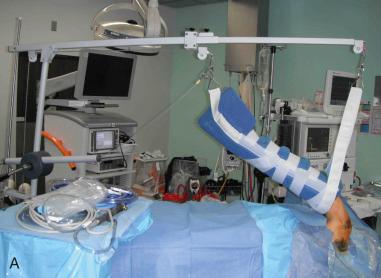
Lateral positioning of the patient occurs after the patient is intubated while supine on a standard operating room table with the bean bag already underneath him/her, but uninflated (see Fig. 39.1A ). The patient is then turned to the lateral position with the operative arm up and the torso posteriorly tilted approximately 20 degrees to position the glenoid parallel with the floor. An axillary roll is placed and the legs are positioned with adequate pillows and cushioning to protect bony prominences and the peroneal nerve as it passes around the fibular neck. The bean bag is then inflated, warm blankets are placed over the patient, and a belt is secured over as opposed to under the blankets so it is always clear that the belt is in place. The arm undergoing surgery is then positioned in approximately 70 degrees of abduction and 20 degrees of forward flexion. One cadaveric study showed that positioning the arm in 45 degrees of flexion with arm abduction of either 0 or 90 degrees allowed for the best visualization with the least amount of strain placed on the brachial plexus. To distend the joint, 10 to 15 lb of traction is applied to a device set up at the foot of the bed. The arm is prepared and draped so that the entire shoulder and part of the arm is sterile and the distal extent of the arm that is hooked up to traction is not sterile and is draped out of the field. Some surgeons believe that the lateral position allows better visualization of the joint because of the traction. Lateral positioning has been reported to have a 10% rate of neurapraxia; most cases resolve in 48 hours. The neurapraxia is thought to be a result of traction on the brachial plexus, with biomechanical studies showing a 100% incidence of abnormal somatosensory evoked potentials in the musculoskeletal nerve.
Beach chair positioning often entails the use of a specialized operating table that bends to create a semiseated, or beach chair, position (see Fig. 39.1B ). The patient is anesthetized while supine and then positioned. The anesthesiologist stabilizes the head while the surgeon and assistant move the patient cephalad on the table and the head holder attachment is positioned on the bed. A padded face mask is placed over the patient's face to hold the head against the head rest. A padded side post is placed on each side of the patient to hold him or her in position on the middle of the bed, and a pillow is placed under the knees to prop the patient up and prevent him or her from sliding down the beach chair. The heels are padded. Unlike with the lateral position, no traction is necessary when the beach chair position is used. The entire operative arm is prepped and draped so it is free for manipulation and movement throughout the operation. Some surgeons find it helpful to use a device that holds the operative arm in various adjustable positions, to free up the hands of their assistants so they can help with the case. The beach chair position facilitates an easy transition to an open procedure because the patient is already in a suitable position for an open procedure. Risks relating to head position do accompany the use of the beach chair position, and neurapraxia of cutaneous nerves in the cervical plexus related to the headrest itself has been reported, and thus a padded head rest should be carefully positioned and neck flexion should be avoided. Also unique to beach chair positioning is the risk of hypoperfusion to the brain. Although the use of hypotensive anesthetic has been well supported in the literature for patients in the supine or lateral decubitus position to decrease operative blood loss and to improve visualization, concern exists about relative hypotension to the brain as a result of hydrostatic pressure. The literature includes rare case reports of patients who have sustained ischemic brain and spinal cord injury while receiving hypotensive anesthesia in the beach chair position. Therefore it has been recommended that blood pressure be measured in the contralateral arm and that attempts be made to keep systolic blood pressure and subacromial pressure (pump pressure) within 49 mm Hg of each other.
Arthroscopy is an equipment-intensive procedure. It involves the use of an arthroscope, which is a small fiber-optic camera that is usually 4 mm in size when used for the shoulder. The arthroscope projects images onto a television that can be seen by all the surgical team members. Arthroscopes come with varying degrees of angulation of the lens, but most commonly the 30-degree arthroscope is used for shoulder arthroscopy. It is advisable to have both 30- and 70-degree scopes available because each scope allows improved visualization depending on the procedure to be performed.
Arthroscopy involves the inflow of fluid through the joint both to distend the joint and to decrease bleeding. The best fluid to use with arthroscopy is a topic of debate. Some studies have shown that epinephrine allows better visualization, likely by decreasing bleeding without associated cardiovascular adverse effects ; however, other in vitro studies have suggested that epinephrine may damage articular cartilage. Therefore we prefer to use the most diluted epinephrine in saline solution for our irrigation fluid. Surgeon preference also determines the use of gravity versus a pressure-controlled pump to manage irrigation inflow.
Outflow of fluid from the shoulder joint occurs through suction tubing attached to the motorized burr, which is a rotating blade within a smooth sheath. The suction of fluid through the burr allows debris and other tissue to be sucked into the shaver and removed from the joint.
Thermal heat in the form of monopolar devices are used for anticoagulation. Cartilage is sensitive to heat, with chondrocyte death being shown to occur with exposure to temperatures as low as 45°C, whereas devices provide heat at temperatures greater than 100°C. Furthermore, previous use of thermal heat for capsulorrhaphy resulted in multiple complications, including chondrolysis, which will be discussed later. Therefore intra-articular devices providing thermal heat are used sparingly for débridement and mainly for anticoagulation to provide good visualization.
One of the potentially limiting factors of arthroscopy is bleeding that compromises the ability to visualize pathology. Burkhart and Lo describe four main factors to consider when attempting to control bleeding. First, the patient's systolic blood pressure should be kept between 90 and 100 mm Hg in the absence of medical contraindications. Second, arthroscopic pump pressure should be kept at around 60 mm Hg, with intermittent increases to 75 mm Hg as needed for visualization (for only 10 to 15 minutes at a time). If the pump pressure is not regulated and is too high, the shoulder will swell, which compromises the surgical technique. Third, if possible, a separate 8-mm inflow cannula should be used to maximize fluid flow. Surgical instrumentation through this portal should be limited because it may increase turbulence. Finally, turbulence within the system must be minimized. Turbulence occurs as a result of rapid flow of fluid out of the shoulder, such as through a skin portal without a cannula. As Burkhart and Lo indicate, the Bernoulli effect creates forces at right angles of the many capillaries in the subacromial space, increasing the bleeding into the operative field. Digital pressure over skin portals can obstruct the outflow of fluid and in effect decrease turbulence.
Having a thorough understanding of basic shoulder anatomy is essential to developing good shoulder arthroscopic technique. We will first address the superficial anatomy, which is the guide to adequate portal placement and thus facilitates maneuverability about the shoulder joint ( Fig. 39.2 ). We start by palpating the bony anatomy. It is important to mark not only the superficial edge of the bone but also the depth of the bone because trocar placement must be directed inferior to the edge of the bone. The clavicle and the anterolateral and posterolateral acromion are outlined. A soft triangle that is often palpable just medial to the acromion serves as a guide. Anteriorly the clavicle can be palpated, moving laterally to where it meets the acromion at the acromioclavicular joint. The coracoid is another important anterior landmark that can be palpated and should be drawn out as well. The posterolateral acromion is a key landmark that can be felt even in larger patients.
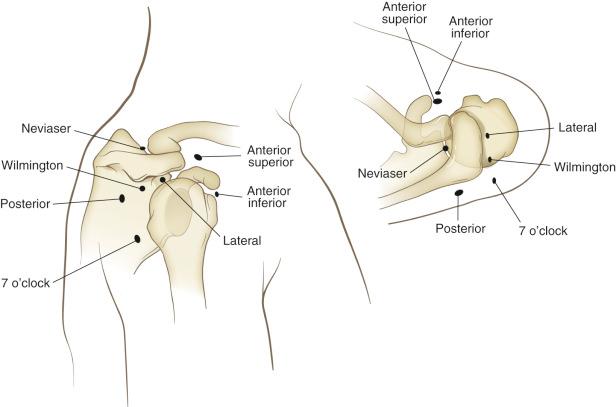
Once the superficial anatomy is appreciated for each individual patient, portal placement sites are marked on the skin. We start with the posterior portal first. This portal is made 2 cm inferior and 1 to 2 cm medial to the posterolateral edge of the acromion. A sharp scalpel is used to make a deep incision. The trocar is then slowly advanced; it is aimed superior, anterior, and medial, toward the coracoid process anteriorly. The trocar is advanced through soft tissue, and often a soft gap can be gently appreciated between the glenoid and humeral head. In addition, the arm can be internally or externally rotated, and if this movement is felt with the trocar, it is on the humeral head and should be directed to a greater degree medially. If no movement is felt, the trocar may be on the glenoid and needs to be directed to a greater degree laterally. The trocar is advanced until it is felt to “pop” through the capsule of the glenohumeral joint. One way to tell if the trocar is in the shoulder joint instead of the subacromial space is to judge the ease of movement of the trocar superiorly and inferiorly, as would be suggested by the proper location in the shoulder joint. Furthermore, if synovial fluid drips out of the cannula when the trocar is removed, proper placement in the glenohumeral joint is likely. The camera is then introduced into this portal, and one can either proceed with a diagnostic examination or place the anterior portal. We prefer to evaluate the rotator interval and then place the anterior portal as the next step.
The anterior portal is ideally placed lateral to the coracoid process through the rotator interval. The portal should never be placed in a position that is inferior or medial to the coracoid process because that would place neurovascular structures at risk. We prefer to visualize the anterior portal as it is placed from an outside-in technique. Therefore the arthroscope is kept in the posterior portal and moved anteriorly to view the rotator interval between the biceps tendon and the subscapularis tendon. A finger depresses the skin from the anterior side and is viewed on the arthroscope to be within the rotator interval. A spinal needle is then advanced into this area. If we are satisfied with this position for the anterior portal, a superficial skin incision is made (a deeper incision may create bleeding that will obscure visualization). The anterior portal is used mainly for instruments, but often surgeons alternate between portals depending on the procedure being performed.
To access the subacromial space, the same initial posterior portal is used, but the trocar is directed more superiorly. The trocar and cannula are advanced so that they hit the acromion and slide just inferior to it. The surgeon's other hand is used to palpate the anterior acromion and the trocar is advanced until it too can be palpated interiorly just inferior to the acromion. Often the coracoacromial ligament can be palpated with the trocar anteriorly, giving a good indication that the trocar is in the subacromial space. Medial to lateral movement of the trocar clears off some of the bursa that is often found with chronic impingement and is often located more posteriorly. Next, a lateral portal is established. This portal is made just inferior to the lateral border of the acromion, at the anterior third to middle third of the acromion, often 1 to 2 cm posterior to the anterolateral border of the acromion. We like to use a spinal needle to judge our position before creating the portal because we try to position the portal so it is as parallel to the acromion as possible to make the decompression easier.
Accessory portals can be made depending on the procedure to be performed. Often additional portals are useful for instability procedures for anchor placement.
We perform a standard diagnostic examination for each patient regardless of the planned procedure or diagnosis to ensure that no possible lesions are overlooked. We start with the arthroscope in the posterior portal and orient our position with the glenoid and humeral head in an upright position to go along with the patient in a beach chair position ( Fig. 39.3A–D ). The glenoid and humeral head are evaluated for signs of cartilage damage or the presence of osteoarthritis. The superior labrum–biceps tendon complex is a good landmark to find early because the biceps is seen traversing the glenohumeral joint from the labrum to its exit out of the glenohumeral joint. The labrum is evaluated for tears or degenerative fraying ( Fig. 39.4 ). A probe can be used to check the stability of the labrum by pulling it away from the glenoid. Having a small foramen between the anterior–superior labrum and the glenoid is a normal variant that is often associated with a cordlike middle glenohumeral ligament. The biceps is followed out to where it exits the glenohumeral joint, and a probe can be used to pull the biceps into the joint to look for signs of inflammation. The superior glenohumeral ligament is seen within the rotator interval, between the biceps tendon and subscapularis, and can be evaluated for thickening associated with frozen shoulder or looseness associated with laxity. If the arthroscope is turned inferiorly, the superior border of the subscapularis tendon can be visualized and followed laterally to its insertion onto the lesser tuberosity of the humerus. The anterior labrum is evaluated, and moving more inferiorly, the anterior and posterior labrum and glenohumeral ligaments are evaluated. The anterior-inferior glenohumeral ligament and labral complex makes up the classic Bankart lesion that is seen in anterior shoulder instability ( Fig. 39.5 ).
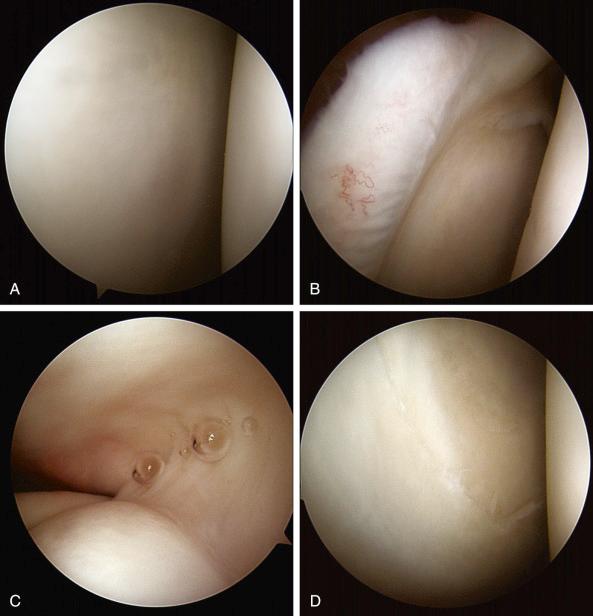
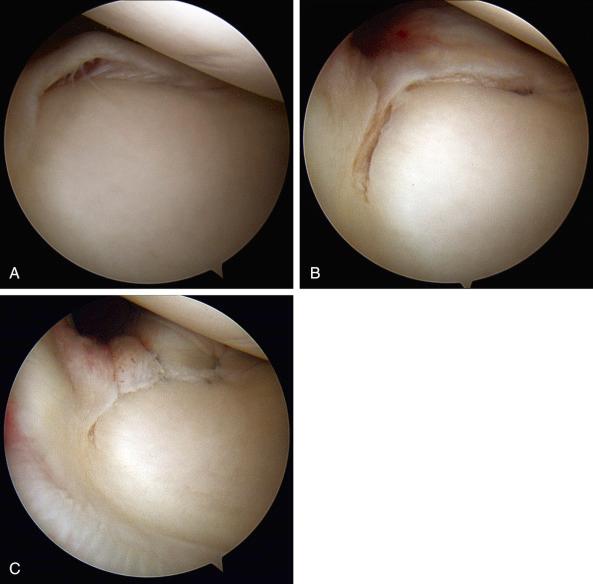
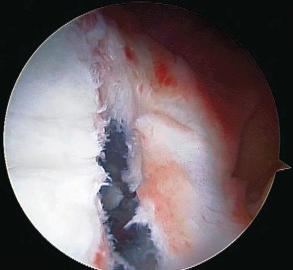
To evaluate posterior portions of the rotator cuff, the anterior edge of the supraspinatus is visualized just lateral to the biceps tendon exit point and can be evaluated throughout its tendinous portion, moving posteriorly both by moving the camera posteriorly and by abducting the arm and externally rotating the arm. Posteriorly the supraspinatus insertion on the greater tuberosity ends and a bare area is seen because a gap exists between the edge of the articular surface and the infraspinatus insertion. Pitting is commonly seen in this area and represents vascular channels. Continuing posteriorly, the posterolateral humeral head can be seen, and the presence or absence of a Hill-Sachs lesion is confirmed. Moving more inferiorly, the axillary pouch is examined to ensure that no loose bodies are present.
Finally, the posterior labrum and capsule are examined by slowly backing the arthroscope out of the posterior portal until they come into view, taking care not to pull the scope out completely. The posterior anatomy can be evaluated further by switching the arthroscope to the anterior portal as well.
Often a diagnostic scope of the subacromial space also should be performed. The camera is inserted as previously described, with management of bursal tissue being the key to good visualization. To begin the examination, the anterior acromion and coracoacromial ligament are evaluated for impingement. The subacromial space also can be used to evaluate the bursal side of the rotator cuff. To evaluate the rotator cuff, the scope is then turned to look inferiorly so that the top or bursal side of the rotator cuff can be evaluated. Signs of impingement are suggested by the presence of fraying, inflammation, or partial bursal-sided rotator cuff tears. If partial-thickness articular-sided tears of the rotator cuff are suspected, a Prolene suture can be passed from the joint side through the rotator cuff and evaluated as it exits the cuff on the subacromial side. If a rent is visualized at the point where the suture comes through, then the tear is actually full thickness.
Become a Clinical Tree membership for Full access and enjoy Unlimited articles
If you are a member. Log in here